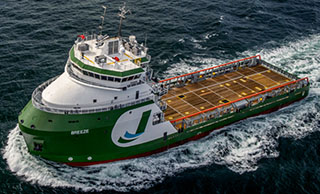Oil companies are becoming more efficient and offshore service vessel companies must do the same. That was the message that Matt Rigdon, chief operating officer, Jackson Offshore Operators, had for attendees at the WorkBoat Regional Summit “OSV Outlook for 2016 and Beyond” held in Houston earlier this month.
“The market has been massively overbuilt,” said Rigdon. “You’re going to start seeing consolidation. Some of the larger publicly traded companies won’t be around.”
Jackson Offshore focused on building larger boats that can bring more cargo to the desired offshore facility. The company took delivery of four 252'x60'x25.7' OSVs (Breeze, Thunder, Lightning, Squall) from BAE Systems over the past two years. Designed by Guido Perla & Associates and recognized as one of WorkBoat’s 10 Significant Boats in 2015, the new OSVs have capacities that include 253,577 gals of fuel; 468,826 gals. rig water; 10,752 bbls. liquid mud; 2,130 bbls. methanol; 119,184 gals. potable water (cargo); and 10,200 cu. ft. dry bulk material. “All our vessels are on long-term contract,” Rigdon said.
There are a number of changes boat companies are going to see thanks to a shift in oil company expectations. In other words, oil companies will be spending less on contracted equipment. Couple that with an oversupply of boats and you get a very competitive industry going forward. “There will be a priority placed on safety,” he cautioned.
Personnel, the right personnel, could be a challenge when the market begins to turn around. “Some personnel are moving to another industry,” Rigdon said. Those who will crew the boats in the future have to be able to troubleshoot when problems occur and be able to make repairs, all while being paid a smaller wage.
Other ways to increase efficiency are to employ diesel-electric engines and be able to use battery backup during transit instead of bringing another engine on line, when that can be done safely. Main diesel-electric propulsion for the new Jackson Offshore OSVs comes from twin Caterpillar 3516C diesel engines, producing 2,100 kW (2,815 hp) at 1,800 rpm each and two Cat C32 diesel engines, cranking out 910 kW (1,220 hp) at 1,800 rpm.





